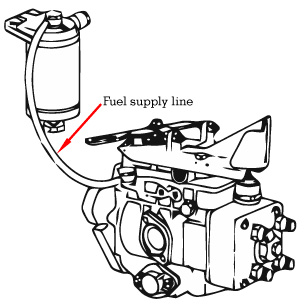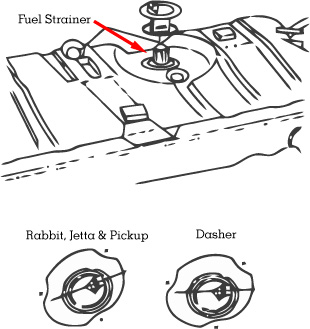Check fuel supply
 Check the clear fuel line between the filter ind the injection pump.
Check the clear fuel line between the filter ind the injection pump.
If the fuel in the line is of a whitish color, wax crystals are forming in the fuel – see ‘Overcoming Cold Weather Problems With Diesel Fuel’ at THIS LINK.
If there is no fuel in the line:
- Check for fuel in the tank
- Check for air leaks at the fuel filter assembly or fuel supply lines
- Remove the fuel filter and check to see if it is plugged
Remove fuel tank strainer
(Rabbit, Jetta, Dasher, and Pick-up only)
 In areas where the temperature drops below 20° F, the fuel tank strainer should be removed.
In areas where the temperature drops below 20° F, the fuel tank strainer should be removed.
- Remove the fuel gauge sending unit.
- Remove the fuel tank strainer.
- Replace the O ring for the sending unit and lubricate it with graphite powder.
- Install the fuel gauge sending unit (note the installation position).
If wax crystals are visible in the fuel tank, see ‘Overcoming Cold Weather Problems With Diesel Fuel’ at THIS LINK.
Check fuel supply to injectors
 After it has been established that fuel is being delivered to the injection pump, loosen an injector line at one of the injectors.
After it has been established that fuel is being delivered to the injection pump, loosen an injector line at one of the injectors.
Crank the engine to see if fuel is being delivered to the injectors.
Goggles should be worn and a fire extinguisher should be kept close by.
- If no fuel is supplied to the injectors check the power supply to the fuel shut-off solenoid.
- If the power supply is o.k., replace the shut-off solenoid
Verify fuel quality
Poor fuel quality can cause a cold running problem or a no start condition. The causes could be:
Fuel not winterized — At temperatures below 20°F, wax crystals begin to form in the fuel. This will plug the fuel lines, cutting off the fuel supply to the engine.
Improper mixing — If too much gasoline or other flow improvers are mixed with the fuel, the cetane rating of the fuel will be lowered below the point at which it will burn properly in the engine
